Report on Care Planning Processes in Healthcare Practice, Unit 20
VerifiedAdded on 2023/01/03
|26
|5817
|97
Report
AI Summary
This report provides a comprehensive analysis of care planning processes within a healthcare practice setting. It begins by comparing different assessment models, including the social and medical models, and their implementation. The report then discusses the application of theoretical perspectives, such as behavioral and sociological approaches, to the care planning process. It delves into the responsibilities of promoting person-centered care, analyzing the contributor's role and the use of care plans. Furthermore, it explores the barriers to implementing care planning and reviews the benefits of care plans in prioritizing individual needs. The report also examines how individuals and families contribute to the evaluation of the care process, reviewing aspects of the care planning process and their impact on individuals, families, and carers. The report also discusses the legislative and regulatory framework that supports equality and diversity in the assessment and care planning process, including the Care Act and the Equality Act.
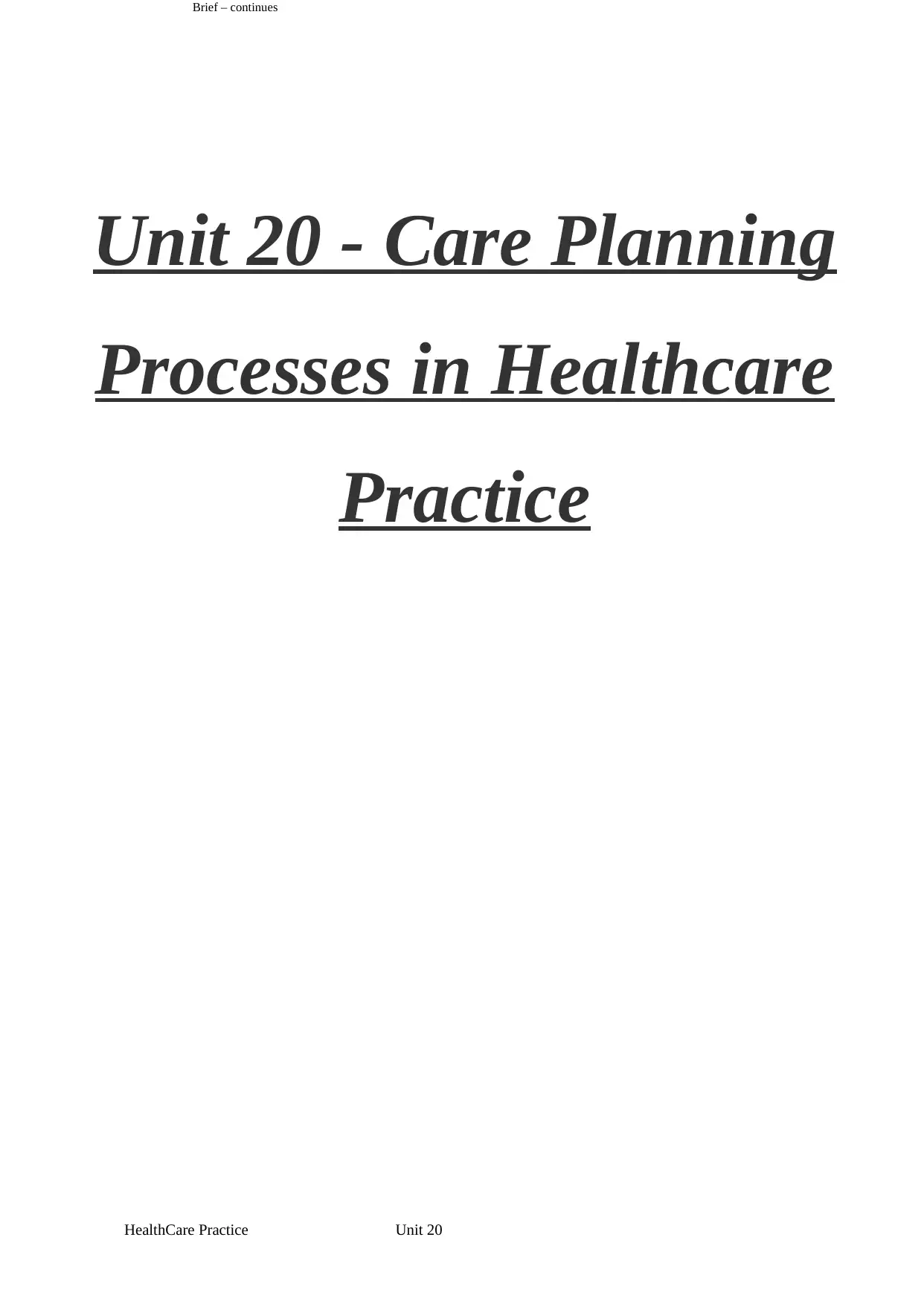
Brief – continues
HealthCare Practice Unit 20
Unit 20 - Care Planning
Processes in Healthcare
Practice
HealthCare Practice Unit 20
Unit 20 - Care Planning
Processes in Healthcare
Practice
Paraphrase This Document
Need a fresh take? Get an instant paraphrase of this document with our AI Paraphraser
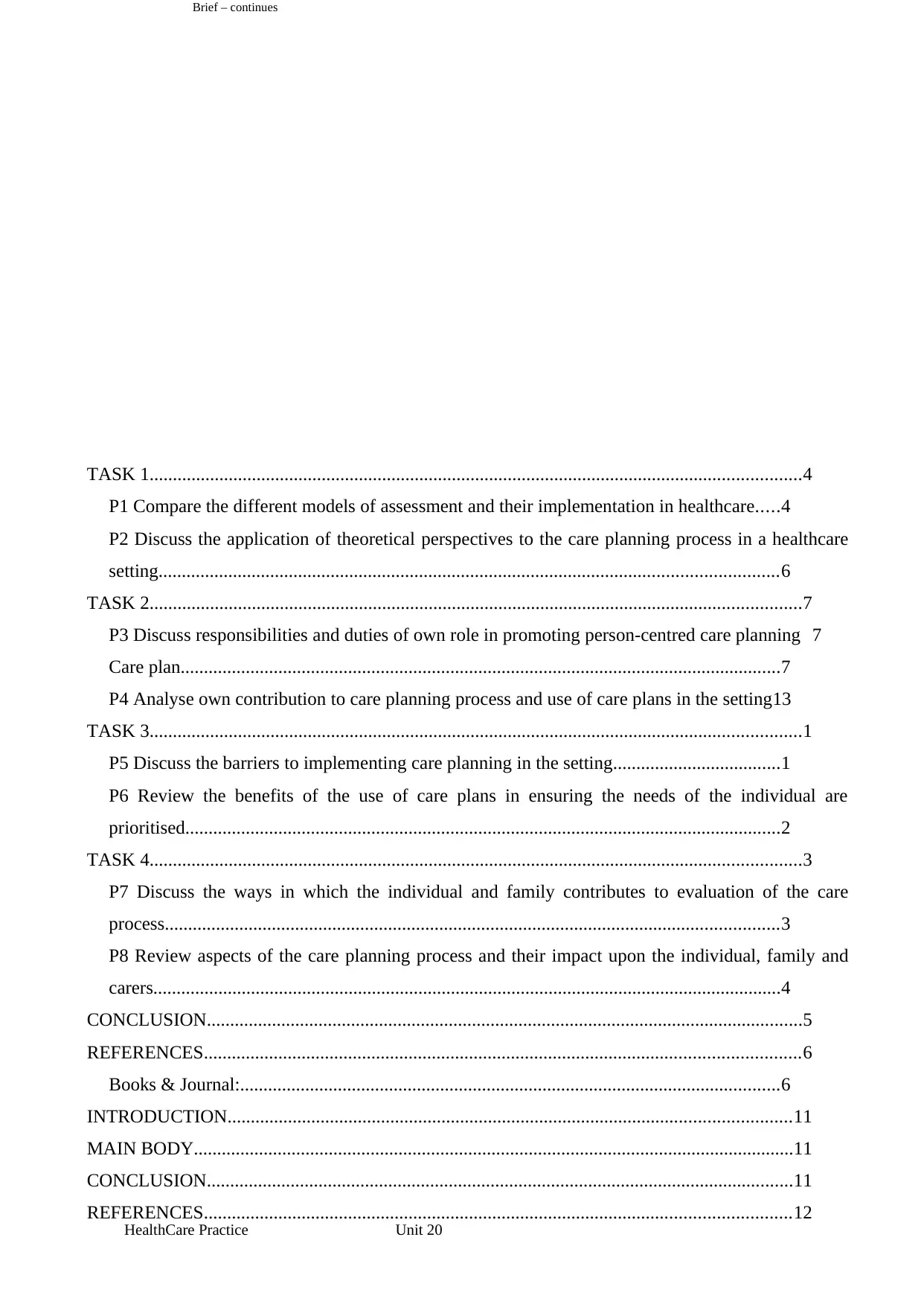
Unit 20HealthCare Practice
Brief – continues
TASK 1............................................................................................................................................4
P1 Compare the different models of assessment and their implementation in healthcare.....4
P2 Discuss the application of theoretical perspectives to the care planning process in a healthcare
setting.....................................................................................................................................6
TASK 2............................................................................................................................................7
P3 Discuss responsibilities and duties of own role in promoting person-centred care planning 7
Care plan.................................................................................................................................7
P4 Analyse own contribution to care planning process and use of care plans in the setting13
TASK 3............................................................................................................................................1
P5 Discuss the barriers to implementing care planning in the setting....................................1
P6 Review the benefits of the use of care plans in ensuring the needs of the individual are
prioritised................................................................................................................................2
TASK 4............................................................................................................................................3
P7 Discuss the ways in which the individual and family contributes to evaluation of the care
process....................................................................................................................................3
P8 Review aspects of the care planning process and their impact upon the individual, family and
carers.......................................................................................................................................4
CONCLUSION................................................................................................................................5
REFERENCES................................................................................................................................6
Books & Journal:....................................................................................................................6
INTRODUCTION.........................................................................................................................11
MAIN BODY.................................................................................................................................11
CONCLUSION..............................................................................................................................11
REFERENCES..............................................................................................................................12
Brief – continues
TASK 1............................................................................................................................................4
P1 Compare the different models of assessment and their implementation in healthcare.....4
P2 Discuss the application of theoretical perspectives to the care planning process in a healthcare
setting.....................................................................................................................................6
TASK 2............................................................................................................................................7
P3 Discuss responsibilities and duties of own role in promoting person-centred care planning 7
Care plan.................................................................................................................................7
P4 Analyse own contribution to care planning process and use of care plans in the setting13
TASK 3............................................................................................................................................1
P5 Discuss the barriers to implementing care planning in the setting....................................1
P6 Review the benefits of the use of care plans in ensuring the needs of the individual are
prioritised................................................................................................................................2
TASK 4............................................................................................................................................3
P7 Discuss the ways in which the individual and family contributes to evaluation of the care
process....................................................................................................................................3
P8 Review aspects of the care planning process and their impact upon the individual, family and
carers.......................................................................................................................................4
CONCLUSION................................................................................................................................5
REFERENCES................................................................................................................................6
Books & Journal:....................................................................................................................6
INTRODUCTION.........................................................................................................................11
MAIN BODY.................................................................................................................................11
CONCLUSION..............................................................................................................................11
REFERENCES..............................................................................................................................12
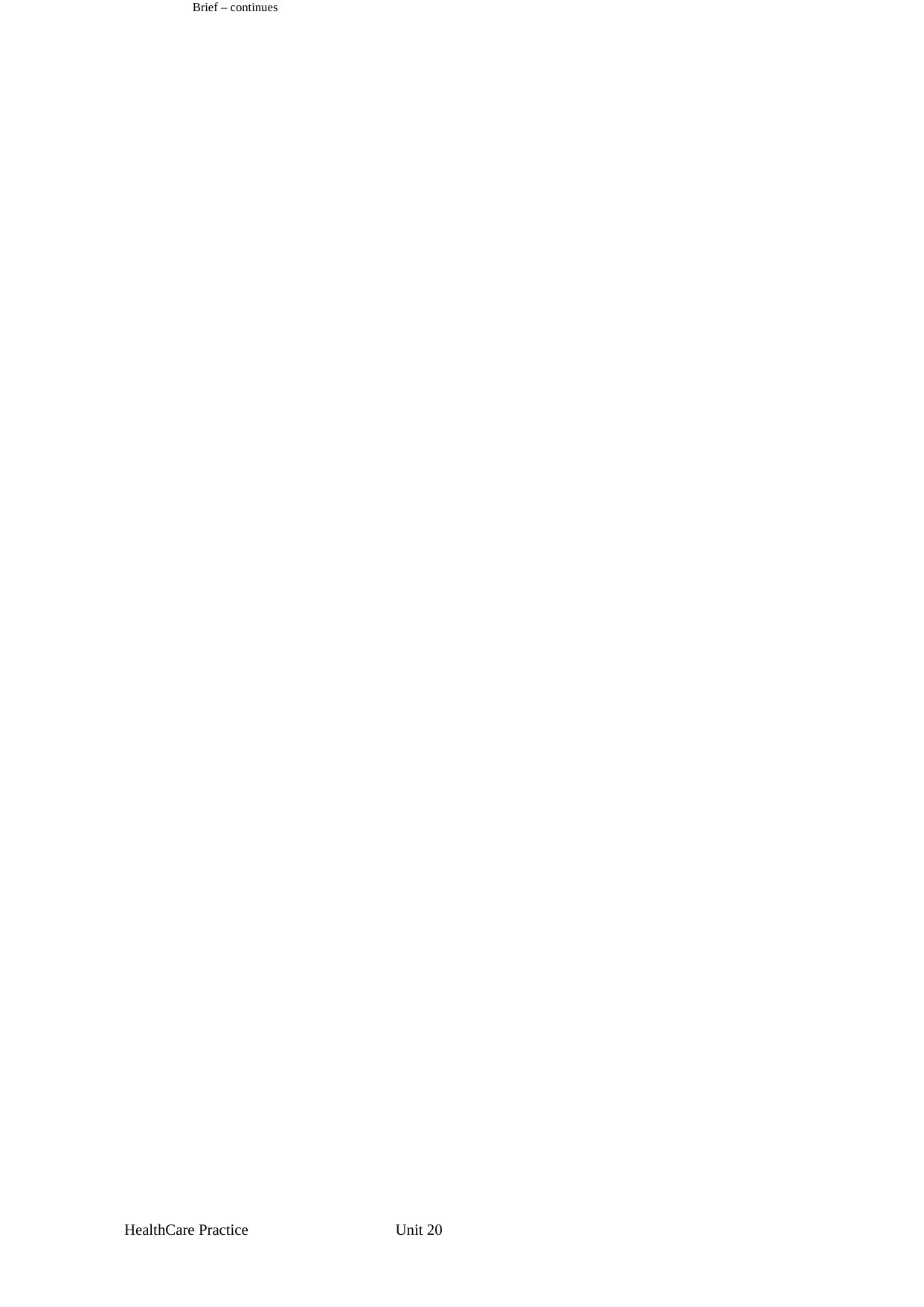
Unit 20HealthCare Practice
Brief – continues
Brief – continues
⊘ This is a preview!⊘
Do you want full access?
Subscribe today to unlock all pages.

Trusted by 1+ million students worldwide
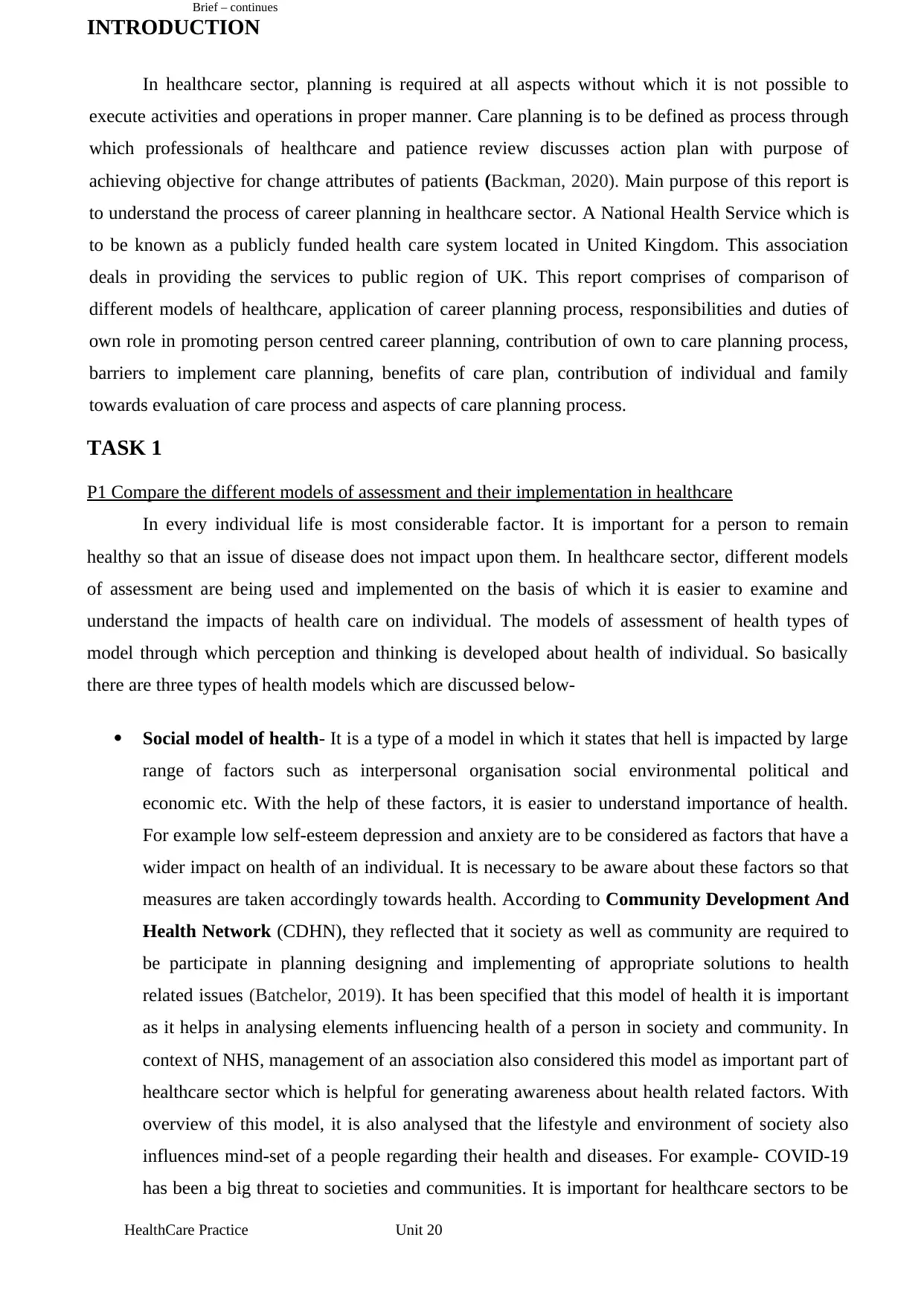
Unit 20HealthCare Practice
Brief – continues
INTRODUCTION
In healthcare sector, planning is required at all aspects without which it is not possible to
execute activities and operations in proper manner. Care planning is to be defined as process through
which professionals of healthcare and patience review discusses action plan with purpose of
achieving objective for change attributes of patients (Backman, 2020). Main purpose of this report is
to understand the process of career planning in healthcare sector. A National Health Service which is
to be known as a publicly funded health care system located in United Kingdom. This association
deals in providing the services to public region of UK. This report comprises of comparison of
different models of healthcare, application of career planning process, responsibilities and duties of
own role in promoting person centred career planning, contribution of own to care planning process,
barriers to implement care planning, benefits of care plan, contribution of individual and family
towards evaluation of care process and aspects of care planning process.
TASK 1
P1 Compare the different models of assessment and their implementation in healthcare
In every individual life is most considerable factor. It is important for a person to remain
healthy so that an issue of disease does not impact upon them. In healthcare sector, different models
of assessment are being used and implemented on the basis of which it is easier to examine and
understand the impacts of health care on individual. The models of assessment of health types of
model through which perception and thinking is developed about health of individual. So basically
there are three types of health models which are discussed below-
Social model of health- It is a type of a model in which it states that hell is impacted by large
range of factors such as interpersonal organisation social environmental political and
economic etc. With the help of these factors, it is easier to understand importance of health.
For example low self-esteem depression and anxiety are to be considered as factors that have a
wider impact on health of an individual. It is necessary to be aware about these factors so that
measures are taken accordingly towards health. According to Community Development And
Health Network (CDHN), they reflected that it society as well as community are required to
be participate in planning designing and implementing of appropriate solutions to health
related issues (Batchelor, 2019). It has been specified that this model of health it is important
as it helps in analysing elements influencing health of a person in society and community. In
context of NHS, management of an association also considered this model as important part of
healthcare sector which is helpful for generating awareness about health related factors. With
overview of this model, it is also analysed that the lifestyle and environment of society also
influences mind-set of a people regarding their health and diseases. For example- COVID-19
has been a big threat to societies and communities. It is important for healthcare sectors to be
Brief – continues
INTRODUCTION
In healthcare sector, planning is required at all aspects without which it is not possible to
execute activities and operations in proper manner. Care planning is to be defined as process through
which professionals of healthcare and patience review discusses action plan with purpose of
achieving objective for change attributes of patients (Backman, 2020). Main purpose of this report is
to understand the process of career planning in healthcare sector. A National Health Service which is
to be known as a publicly funded health care system located in United Kingdom. This association
deals in providing the services to public region of UK. This report comprises of comparison of
different models of healthcare, application of career planning process, responsibilities and duties of
own role in promoting person centred career planning, contribution of own to care planning process,
barriers to implement care planning, benefits of care plan, contribution of individual and family
towards evaluation of care process and aspects of care planning process.
TASK 1
P1 Compare the different models of assessment and their implementation in healthcare
In every individual life is most considerable factor. It is important for a person to remain
healthy so that an issue of disease does not impact upon them. In healthcare sector, different models
of assessment are being used and implemented on the basis of which it is easier to examine and
understand the impacts of health care on individual. The models of assessment of health types of
model through which perception and thinking is developed about health of individual. So basically
there are three types of health models which are discussed below-
Social model of health- It is a type of a model in which it states that hell is impacted by large
range of factors such as interpersonal organisation social environmental political and
economic etc. With the help of these factors, it is easier to understand importance of health.
For example low self-esteem depression and anxiety are to be considered as factors that have a
wider impact on health of an individual. It is necessary to be aware about these factors so that
measures are taken accordingly towards health. According to Community Development And
Health Network (CDHN), they reflected that it society as well as community are required to
be participate in planning designing and implementing of appropriate solutions to health
related issues (Batchelor, 2019). It has been specified that this model of health it is important
as it helps in analysing elements influencing health of a person in society and community. In
context of NHS, management of an association also considered this model as important part of
healthcare sector which is helpful for generating awareness about health related factors. With
overview of this model, it is also analysed that the lifestyle and environment of society also
influences mind-set of a people regarding their health and diseases. For example- COVID-19
has been a big threat to societies and communities. It is important for healthcare sectors to be
Paraphrase This Document
Need a fresh take? Get an instant paraphrase of this document with our AI Paraphraser
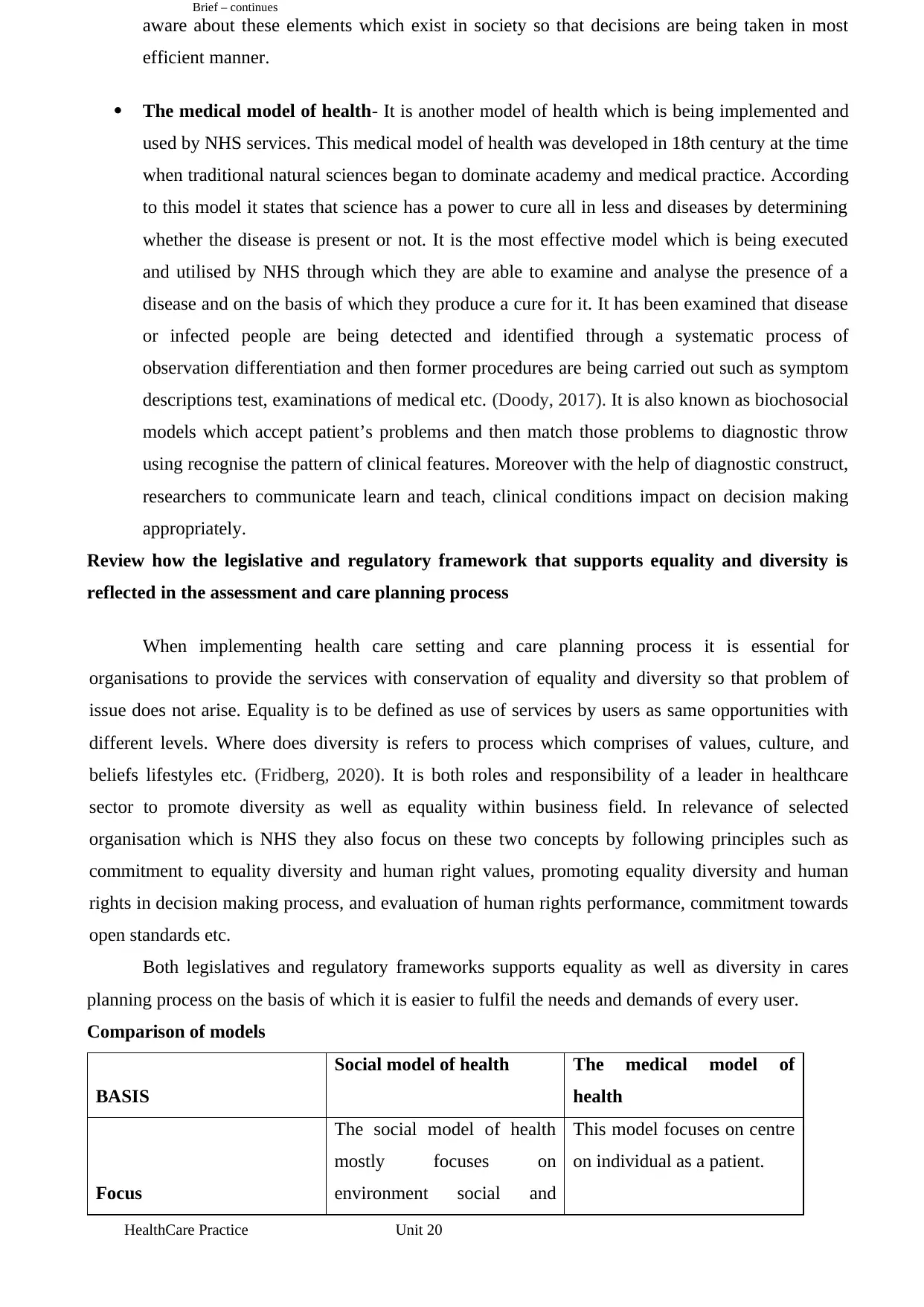
Unit 20HealthCare Practice
Brief – continues
aware about these elements which exist in society so that decisions are being taken in most
efficient manner.
The medical model of health- It is another model of health which is being implemented and
used by NHS services. This medical model of health was developed in 18th century at the time
when traditional natural sciences began to dominate academy and medical practice. According
to this model it states that science has a power to cure all in less and diseases by determining
whether the disease is present or not. It is the most effective model which is being executed
and utilised by NHS through which they are able to examine and analyse the presence of a
disease and on the basis of which they produce a cure for it. It has been examined that disease
or infected people are being detected and identified through a systematic process of
observation differentiation and then former procedures are being carried out such as symptom
descriptions test, examinations of medical etc. (Doody, 2017). It is also known as biochosocial
models which accept patient’s problems and then match those problems to diagnostic throw
using recognise the pattern of clinical features. Moreover with the help of diagnostic construct,
researchers to communicate learn and teach, clinical conditions impact on decision making
appropriately.
Review how the legislative and regulatory framework that supports equality and diversity is
reflected in the assessment and care planning process
When implementing health care setting and care planning process it is essential for
organisations to provide the services with conservation of equality and diversity so that problem of
issue does not arise. Equality is to be defined as use of services by users as same opportunities with
different levels. Where does diversity is refers to process which comprises of values, culture, and
beliefs lifestyles etc. (Fridberg, 2020). It is both roles and responsibility of a leader in healthcare
sector to promote diversity as well as equality within business field. In relevance of selected
organisation which is NHS they also focus on these two concepts by following principles such as
commitment to equality diversity and human right values, promoting equality diversity and human
rights in decision making process, and evaluation of human rights performance, commitment towards
open standards etc.
Both legislatives and regulatory frameworks supports equality as well as diversity in cares
planning process on the basis of which it is easier to fulfil the needs and demands of every user.
Comparison of models
BASIS
Social model of health The medical model of
health
Focus
The social model of health
mostly focuses on
environment social and
This model focuses on centre
on individual as a patient.
Brief – continues
aware about these elements which exist in society so that decisions are being taken in most
efficient manner.
The medical model of health- It is another model of health which is being implemented and
used by NHS services. This medical model of health was developed in 18th century at the time
when traditional natural sciences began to dominate academy and medical practice. According
to this model it states that science has a power to cure all in less and diseases by determining
whether the disease is present or not. It is the most effective model which is being executed
and utilised by NHS through which they are able to examine and analyse the presence of a
disease and on the basis of which they produce a cure for it. It has been examined that disease
or infected people are being detected and identified through a systematic process of
observation differentiation and then former procedures are being carried out such as symptom
descriptions test, examinations of medical etc. (Doody, 2017). It is also known as biochosocial
models which accept patient’s problems and then match those problems to diagnostic throw
using recognise the pattern of clinical features. Moreover with the help of diagnostic construct,
researchers to communicate learn and teach, clinical conditions impact on decision making
appropriately.
Review how the legislative and regulatory framework that supports equality and diversity is
reflected in the assessment and care planning process
When implementing health care setting and care planning process it is essential for
organisations to provide the services with conservation of equality and diversity so that problem of
issue does not arise. Equality is to be defined as use of services by users as same opportunities with
different levels. Where does diversity is refers to process which comprises of values, culture, and
beliefs lifestyles etc. (Fridberg, 2020). It is both roles and responsibility of a leader in healthcare
sector to promote diversity as well as equality within business field. In relevance of selected
organisation which is NHS they also focus on these two concepts by following principles such as
commitment to equality diversity and human right values, promoting equality diversity and human
rights in decision making process, and evaluation of human rights performance, commitment towards
open standards etc.
Both legislatives and regulatory frameworks supports equality as well as diversity in cares
planning process on the basis of which it is easier to fulfil the needs and demands of every user.
Comparison of models
BASIS
Social model of health The medical model of
health
Focus
The social model of health
mostly focuses on
environment social and
This model focuses on centre
on individual as a patient.
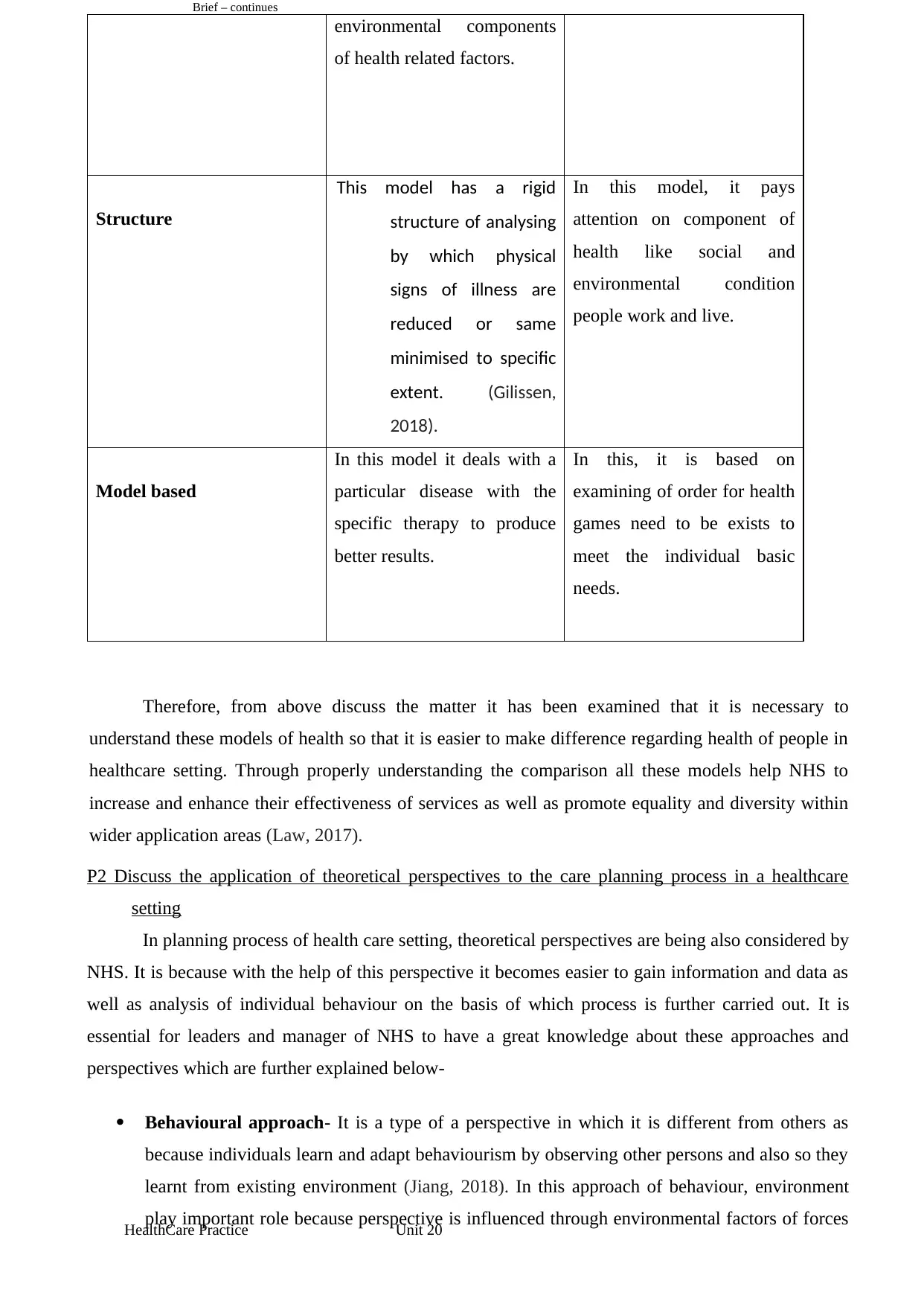
Unit 20HealthCare Practice
Brief – continues
environmental components
of health related factors.
Structure
This model has a rigid
structure of analysing
by which physical
signs of illness are
reduced or same
minimised to specific
extent. (Gilissen,
2018).
In this model, it pays
attention on component of
health like social and
environmental condition
people work and live.
Model based
In this model it deals with a
particular disease with the
specific therapy to produce
better results.
In this, it is based on
examining of order for health
games need to be exists to
meet the individual basic
needs.
Therefore, from above discuss the matter it has been examined that it is necessary to
understand these models of health so that it is easier to make difference regarding health of people in
healthcare setting. Through properly understanding the comparison all these models help NHS to
increase and enhance their effectiveness of services as well as promote equality and diversity within
wider application areas (Law, 2017).
P2 Discuss the application of theoretical perspectives to the care planning process in a healthcare
setting
In planning process of health care setting, theoretical perspectives are being also considered by
NHS. It is because with the help of this perspective it becomes easier to gain information and data as
well as analysis of individual behaviour on the basis of which process is further carried out. It is
essential for leaders and manager of NHS to have a great knowledge about these approaches and
perspectives which are further explained below-
Behavioural approach- It is a type of a perspective in which it is different from others as
because individuals learn and adapt behaviourism by observing other persons and also so they
learnt from existing environment (Jiang, 2018). In this approach of behaviour, environment
play important role because perspective is influenced through environmental factors of forces
Brief – continues
environmental components
of health related factors.
Structure
This model has a rigid
structure of analysing
by which physical
signs of illness are
reduced or same
minimised to specific
extent. (Gilissen,
2018).
In this model, it pays
attention on component of
health like social and
environmental condition
people work and live.
Model based
In this model it deals with a
particular disease with the
specific therapy to produce
better results.
In this, it is based on
examining of order for health
games need to be exists to
meet the individual basic
needs.
Therefore, from above discuss the matter it has been examined that it is necessary to
understand these models of health so that it is easier to make difference regarding health of people in
healthcare setting. Through properly understanding the comparison all these models help NHS to
increase and enhance their effectiveness of services as well as promote equality and diversity within
wider application areas (Law, 2017).
P2 Discuss the application of theoretical perspectives to the care planning process in a healthcare
setting
In planning process of health care setting, theoretical perspectives are being also considered by
NHS. It is because with the help of this perspective it becomes easier to gain information and data as
well as analysis of individual behaviour on the basis of which process is further carried out. It is
essential for leaders and manager of NHS to have a great knowledge about these approaches and
perspectives which are further explained below-
Behavioural approach- It is a type of a perspective in which it is different from others as
because individuals learn and adapt behaviourism by observing other persons and also so they
learnt from existing environment (Jiang, 2018). In this approach of behaviour, environment
play important role because perspective is influenced through environmental factors of forces
⊘ This is a preview!⊘
Do you want full access?
Subscribe today to unlock all pages.

Trusted by 1+ million students worldwide
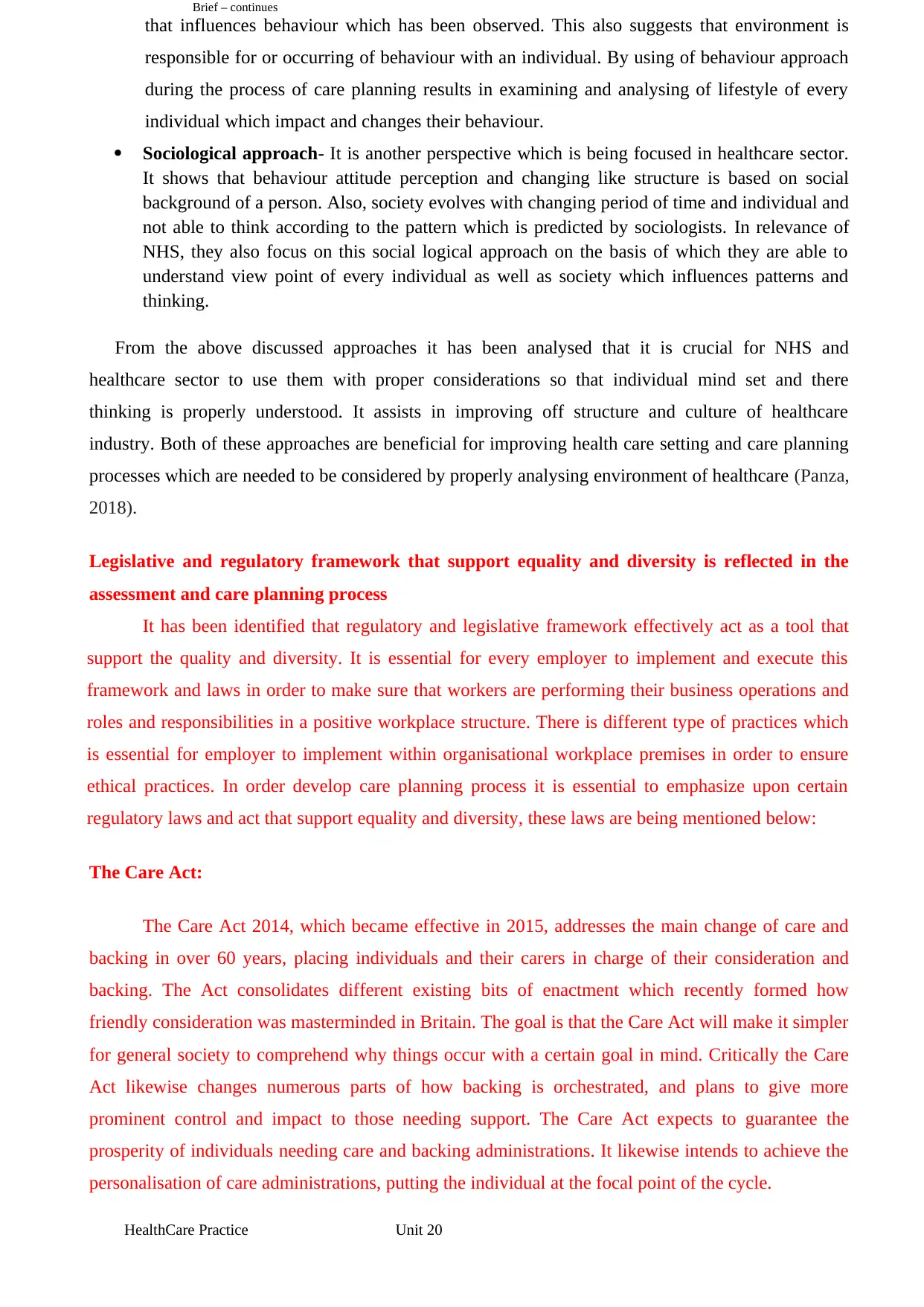
Unit 20HealthCare Practice
Brief – continues
that influences behaviour which has been observed. This also suggests that environment is
responsible for or occurring of behaviour with an individual. By using of behaviour approach
during the process of care planning results in examining and analysing of lifestyle of every
individual which impact and changes their behaviour.
Sociological approach- It is another perspective which is being focused in healthcare sector.
It shows that behaviour attitude perception and changing like structure is based on social
background of a person. Also, society evolves with changing period of time and individual and
not able to think according to the pattern which is predicted by sociologists. In relevance of
NHS, they also focus on this social logical approach on the basis of which they are able to
understand view point of every individual as well as society which influences patterns and
thinking.
From the above discussed approaches it has been analysed that it is crucial for NHS and
healthcare sector to use them with proper considerations so that individual mind set and there
thinking is properly understood. It assists in improving off structure and culture of healthcare
industry. Both of these approaches are beneficial for improving health care setting and care planning
processes which are needed to be considered by properly analysing environment of healthcare (Panza,
2018).
Legislative and regulatory framework that support equality and diversity is reflected in the
assessment and care planning process
It has been identified that regulatory and legislative framework effectively act as a tool that
support the quality and diversity. It is essential for every employer to implement and execute this
framework and laws in order to make sure that workers are performing their business operations and
roles and responsibilities in a positive workplace structure. There is different type of practices which
is essential for employer to implement within organisational workplace premises in order to ensure
ethical practices. In order develop care planning process it is essential to emphasize upon certain
regulatory laws and act that support equality and diversity, these laws are being mentioned below:
The Care Act:
The Care Act 2014, which became effective in 2015, addresses the main change of care and
backing in over 60 years, placing individuals and their carers in charge of their consideration and
backing. The Act consolidates different existing bits of enactment which recently formed how
friendly consideration was masterminded in Britain. The goal is that the Care Act will make it simpler
for general society to comprehend why things occur with a certain goal in mind. Critically the Care
Act likewise changes numerous parts of how backing is orchestrated, and plans to give more
prominent control and impact to those needing support. The Care Act expects to guarantee the
prosperity of individuals needing care and backing administrations. It likewise intends to achieve the
personalisation of care administrations, putting the individual at the focal point of the cycle.
Brief – continues
that influences behaviour which has been observed. This also suggests that environment is
responsible for or occurring of behaviour with an individual. By using of behaviour approach
during the process of care planning results in examining and analysing of lifestyle of every
individual which impact and changes their behaviour.
Sociological approach- It is another perspective which is being focused in healthcare sector.
It shows that behaviour attitude perception and changing like structure is based on social
background of a person. Also, society evolves with changing period of time and individual and
not able to think according to the pattern which is predicted by sociologists. In relevance of
NHS, they also focus on this social logical approach on the basis of which they are able to
understand view point of every individual as well as society which influences patterns and
thinking.
From the above discussed approaches it has been analysed that it is crucial for NHS and
healthcare sector to use them with proper considerations so that individual mind set and there
thinking is properly understood. It assists in improving off structure and culture of healthcare
industry. Both of these approaches are beneficial for improving health care setting and care planning
processes which are needed to be considered by properly analysing environment of healthcare (Panza,
2018).
Legislative and regulatory framework that support equality and diversity is reflected in the
assessment and care planning process
It has been identified that regulatory and legislative framework effectively act as a tool that
support the quality and diversity. It is essential for every employer to implement and execute this
framework and laws in order to make sure that workers are performing their business operations and
roles and responsibilities in a positive workplace structure. There is different type of practices which
is essential for employer to implement within organisational workplace premises in order to ensure
ethical practices. In order develop care planning process it is essential to emphasize upon certain
regulatory laws and act that support equality and diversity, these laws are being mentioned below:
The Care Act:
The Care Act 2014, which became effective in 2015, addresses the main change of care and
backing in over 60 years, placing individuals and their carers in charge of their consideration and
backing. The Act consolidates different existing bits of enactment which recently formed how
friendly consideration was masterminded in Britain. The goal is that the Care Act will make it simpler
for general society to comprehend why things occur with a certain goal in mind. Critically the Care
Act likewise changes numerous parts of how backing is orchestrated, and plans to give more
prominent control and impact to those needing support. The Care Act expects to guarantee the
prosperity of individuals needing care and backing administrations. It likewise intends to achieve the
personalisation of care administrations, putting the individual at the focal point of the cycle.
Paraphrase This Document
Need a fresh take? Get an instant paraphrase of this document with our AI Paraphraser
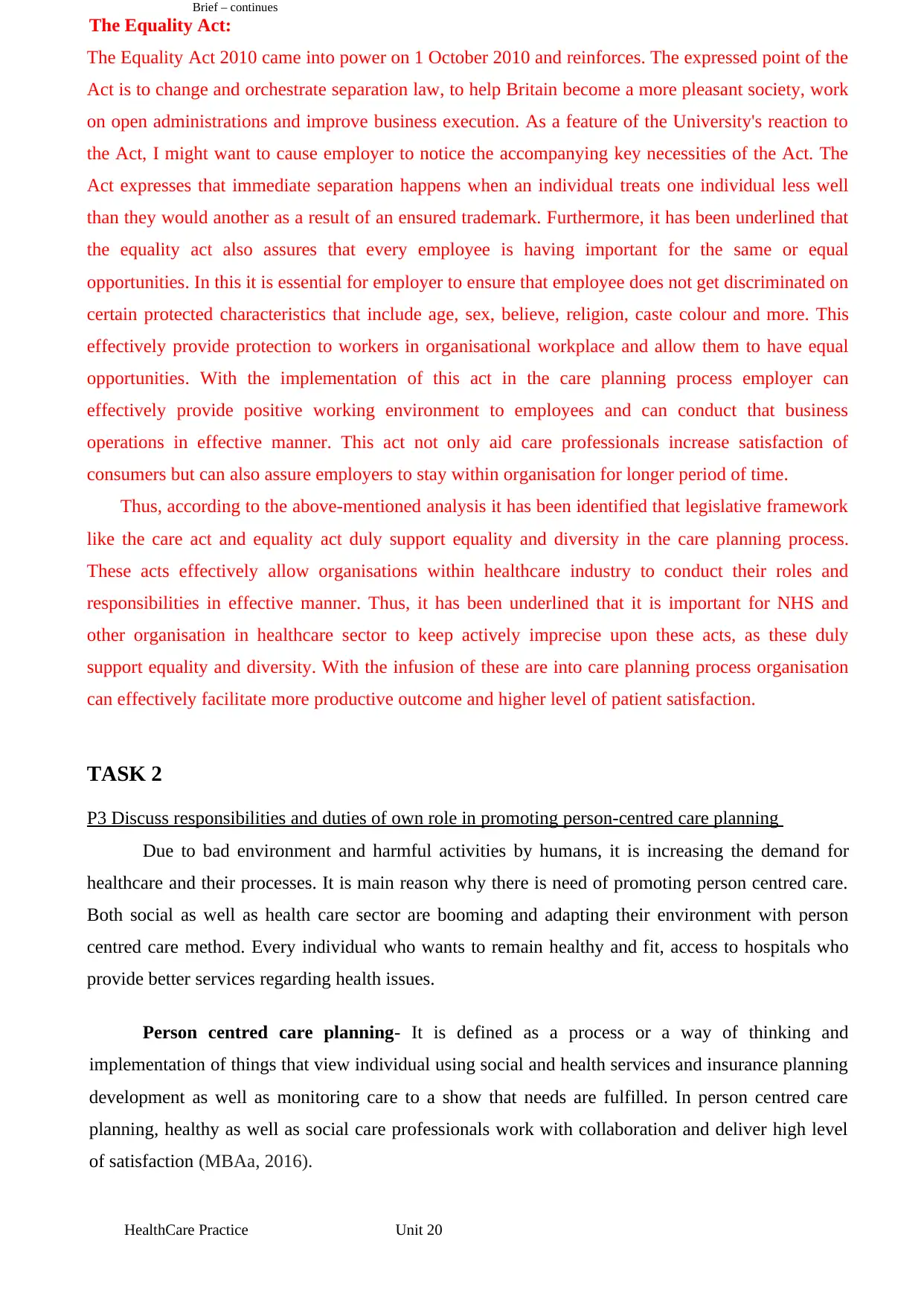
Unit 20HealthCare Practice
Brief – continues
The Equality Act:
The Equality Act 2010 came into power on 1 October 2010 and reinforces. The expressed point of the
Act is to change and orchestrate separation law, to help Britain become a more pleasant society, work
on open administrations and improve business execution. As a feature of the University's reaction to
the Act, I might want to cause employer to notice the accompanying key necessities of the Act. The
Act expresses that immediate separation happens when an individual treats one individual less well
than they would another as a result of an ensured trademark. Furthermore, it has been underlined that
the equality act also assures that every employee is having important for the same or equal
opportunities. In this it is essential for employer to ensure that employee does not get discriminated on
certain protected characteristics that include age, sex, believe, religion, caste colour and more. This
effectively provide protection to workers in organisational workplace and allow them to have equal
opportunities. With the implementation of this act in the care planning process employer can
effectively provide positive working environment to employees and can conduct that business
operations in effective manner. This act not only aid care professionals increase satisfaction of
consumers but can also assure employers to stay within organisation for longer period of time.
Thus, according to the above-mentioned analysis it has been identified that legislative framework
like the care act and equality act duly support equality and diversity in the care planning process.
These acts effectively allow organisations within healthcare industry to conduct their roles and
responsibilities in effective manner. Thus, it has been underlined that it is important for NHS and
other organisation in healthcare sector to keep actively imprecise upon these acts, as these duly
support equality and diversity. With the infusion of these are into care planning process organisation
can effectively facilitate more productive outcome and higher level of patient satisfaction.
TASK 2
P3 Discuss responsibilities and duties of own role in promoting person-centred care planning
Due to bad environment and harmful activities by humans, it is increasing the demand for
healthcare and their processes. It is main reason why there is need of promoting person centred care.
Both social as well as health care sector are booming and adapting their environment with person
centred care method. Every individual who wants to remain healthy and fit, access to hospitals who
provide better services regarding health issues.
Person centred care planning- It is defined as a process or a way of thinking and
implementation of things that view individual using social and health services and insurance planning
development as well as monitoring care to a show that needs are fulfilled. In person centred care
planning, healthy as well as social care professionals work with collaboration and deliver high level
of satisfaction (MBAa, 2016).
Brief – continues
The Equality Act:
The Equality Act 2010 came into power on 1 October 2010 and reinforces. The expressed point of the
Act is to change and orchestrate separation law, to help Britain become a more pleasant society, work
on open administrations and improve business execution. As a feature of the University's reaction to
the Act, I might want to cause employer to notice the accompanying key necessities of the Act. The
Act expresses that immediate separation happens when an individual treats one individual less well
than they would another as a result of an ensured trademark. Furthermore, it has been underlined that
the equality act also assures that every employee is having important for the same or equal
opportunities. In this it is essential for employer to ensure that employee does not get discriminated on
certain protected characteristics that include age, sex, believe, religion, caste colour and more. This
effectively provide protection to workers in organisational workplace and allow them to have equal
opportunities. With the implementation of this act in the care planning process employer can
effectively provide positive working environment to employees and can conduct that business
operations in effective manner. This act not only aid care professionals increase satisfaction of
consumers but can also assure employers to stay within organisation for longer period of time.
Thus, according to the above-mentioned analysis it has been identified that legislative framework
like the care act and equality act duly support equality and diversity in the care planning process.
These acts effectively allow organisations within healthcare industry to conduct their roles and
responsibilities in effective manner. Thus, it has been underlined that it is important for NHS and
other organisation in healthcare sector to keep actively imprecise upon these acts, as these duly
support equality and diversity. With the infusion of these are into care planning process organisation
can effectively facilitate more productive outcome and higher level of patient satisfaction.
TASK 2
P3 Discuss responsibilities and duties of own role in promoting person-centred care planning
Due to bad environment and harmful activities by humans, it is increasing the demand for
healthcare and their processes. It is main reason why there is need of promoting person centred care.
Both social as well as health care sector are booming and adapting their environment with person
centred care method. Every individual who wants to remain healthy and fit, access to hospitals who
provide better services regarding health issues.
Person centred care planning- It is defined as a process or a way of thinking and
implementation of things that view individual using social and health services and insurance planning
development as well as monitoring care to a show that needs are fulfilled. In person centred care
planning, healthy as well as social care professionals work with collaboration and deliver high level
of satisfaction (MBAa, 2016).
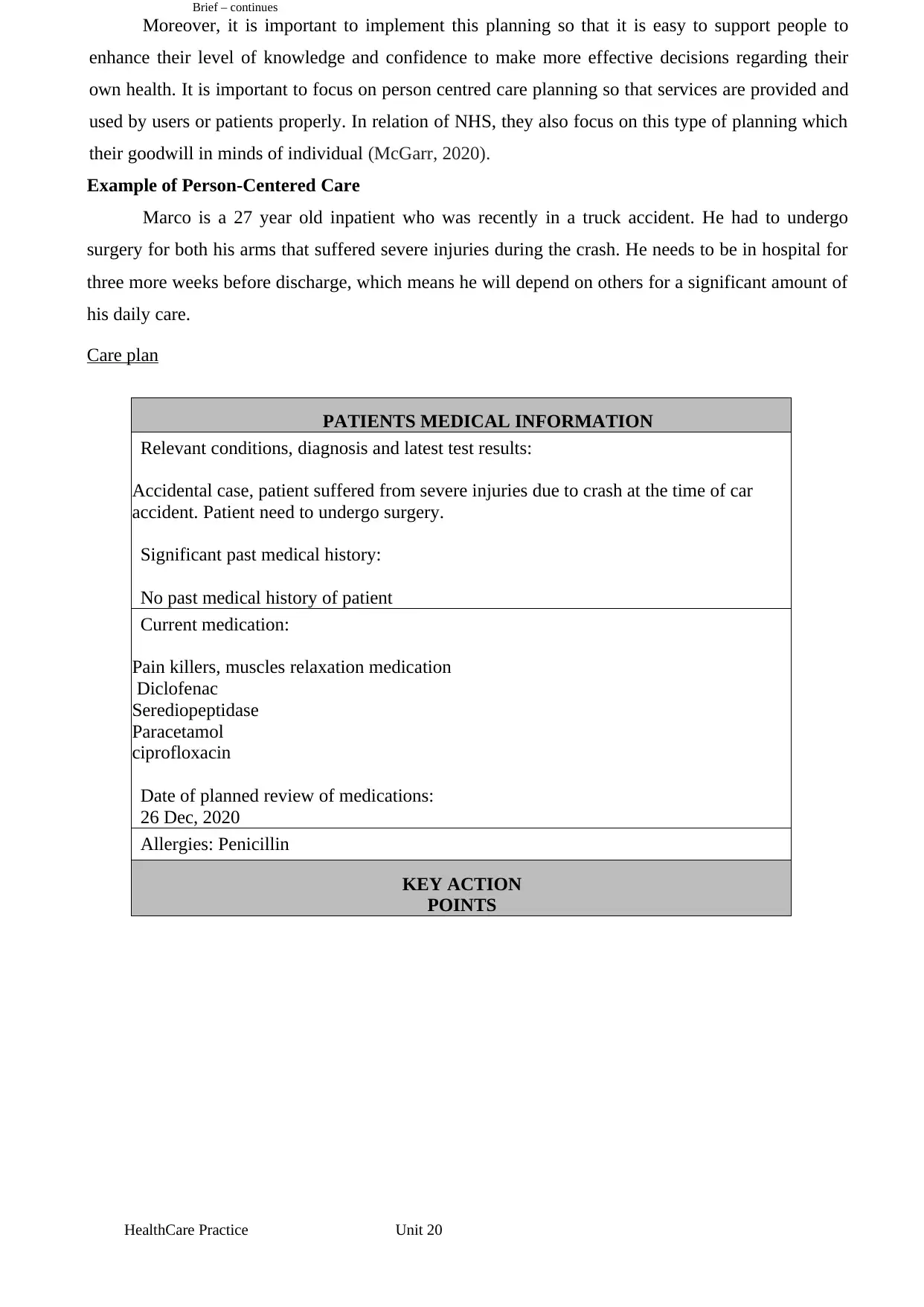
Unit 20HealthCare Practice
Brief – continues
Moreover, it is important to implement this planning so that it is easy to support people to
enhance their level of knowledge and confidence to make more effective decisions regarding their
own health. It is important to focus on person centred care planning so that services are provided and
used by users or patients properly. In relation of NHS, they also focus on this type of planning which
their goodwill in minds of individual (McGarr, 2020).
Example of Person-Centered Care
Marco is a 27 year old inpatient who was recently in a truck accident. He had to undergo
surgery for both his arms that suffered severe injuries during the crash. He needs to be in hospital for
three more weeks before discharge, which means he will depend on others for a significant amount of
his daily care.
Care plan
PATIENTS MEDICAL INFORMATION
Relevant conditions, diagnosis and latest test results:
Accidental case, patient suffered from severe injuries due to crash at the time of car
accident. Patient need to undergo surgery.
Significant past medical history:
No past medical history of patient
Current medication:
Pain killers, muscles relaxation medication
Diclofenac
Serediopeptidase
Paracetamol
ciprofloxacin
Date of planned review of medications:
26 Dec, 2020
Allergies: Penicillin
KEY ACTION
POINTS
Brief – continues
Moreover, it is important to implement this planning so that it is easy to support people to
enhance their level of knowledge and confidence to make more effective decisions regarding their
own health. It is important to focus on person centred care planning so that services are provided and
used by users or patients properly. In relation of NHS, they also focus on this type of planning which
their goodwill in minds of individual (McGarr, 2020).
Example of Person-Centered Care
Marco is a 27 year old inpatient who was recently in a truck accident. He had to undergo
surgery for both his arms that suffered severe injuries during the crash. He needs to be in hospital for
three more weeks before discharge, which means he will depend on others for a significant amount of
his daily care.
Care plan
PATIENTS MEDICAL INFORMATION
Relevant conditions, diagnosis and latest test results:
Accidental case, patient suffered from severe injuries due to crash at the time of car
accident. Patient need to undergo surgery.
Significant past medical history:
No past medical history of patient
Current medication:
Pain killers, muscles relaxation medication
Diclofenac
Serediopeptidase
Paracetamol
ciprofloxacin
Date of planned review of medications:
26 Dec, 2020
Allergies: Penicillin
KEY ACTION
POINTS
⊘ This is a preview!⊘
Do you want full access?
Subscribe today to unlock all pages.

Trusted by 1+ million students worldwide
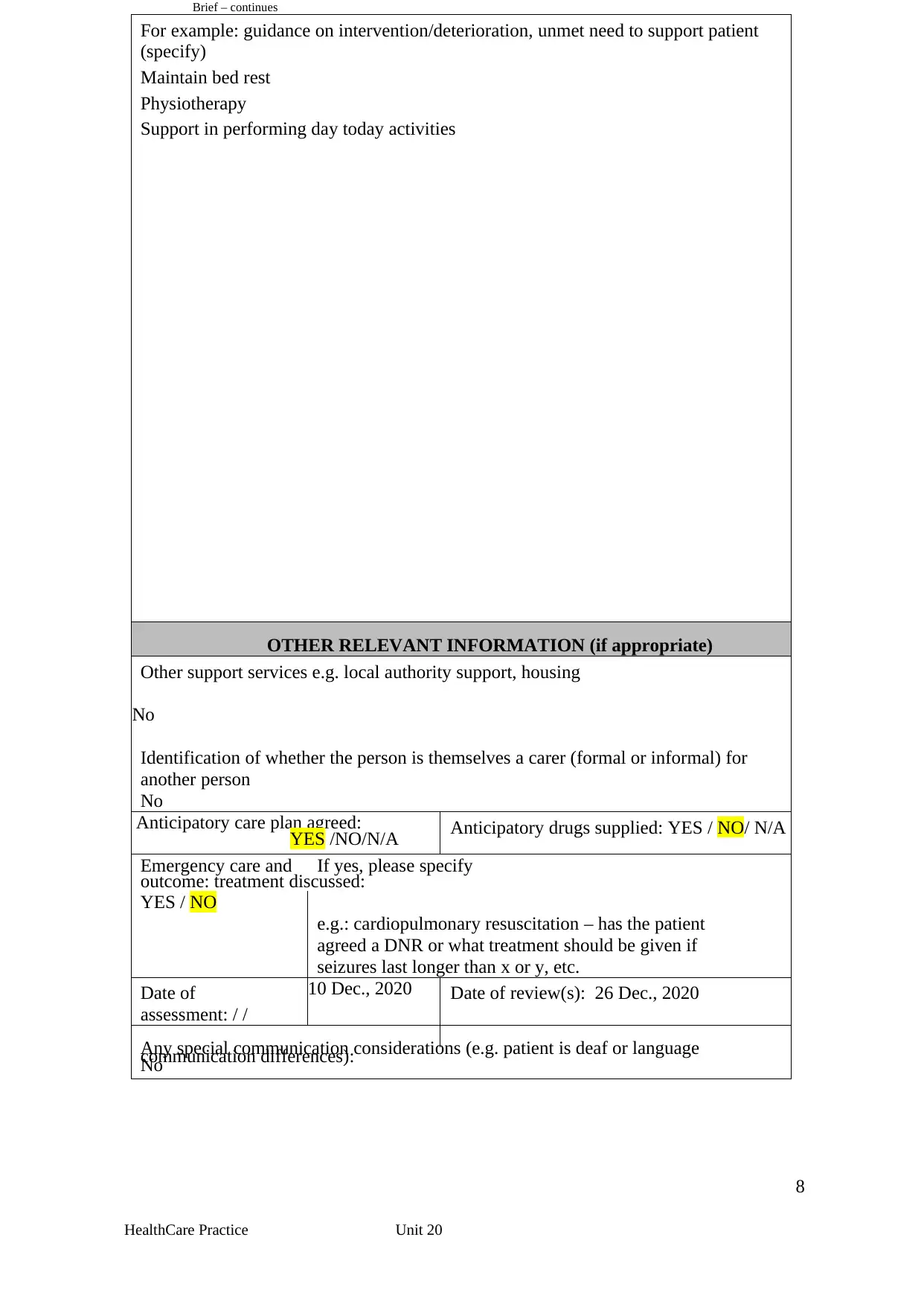
Unit 20HealthCare Practice
Brief – continues
For example: guidance on intervention/deterioration, unmet need to support patient
(specify)
Maintain bed rest
Physiotherapy
Support in performing day today activities
OTHER RELEVANT INFORMATION (if appropriate)
Other support services e.g. local authority support, housing
No
Identification of whether the person is themselves a carer (formal or informal) for
another person
No
Anticipatory care plan agreed:
YES /NO/N/A Anticipatory drugs supplied: YES / NO/ N/A
Emergency care and If yes, please specify
outcome: treatment discussed:
YES / NO
e.g.: cardiopulmonary resuscitation – has the patient
agreed a DNR or what treatment should be given if
seizures last longer than x or y, etc.
Date of
assessment: / /
10 Dec., 2020 Date of review(s): 26 Dec., 2020
Any special communication considerations (e.g. patient is deaf or languagecommunication differences):No
8
Brief – continues
For example: guidance on intervention/deterioration, unmet need to support patient
(specify)
Maintain bed rest
Physiotherapy
Support in performing day today activities
OTHER RELEVANT INFORMATION (if appropriate)
Other support services e.g. local authority support, housing
No
Identification of whether the person is themselves a carer (formal or informal) for
another person
No
Anticipatory care plan agreed:
YES /NO/N/A Anticipatory drugs supplied: YES / NO/ N/A
Emergency care and If yes, please specify
outcome: treatment discussed:
YES / NO
e.g.: cardiopulmonary resuscitation – has the patient
agreed a DNR or what treatment should be given if
seizures last longer than x or y, etc.
Date of
assessment: / /
10 Dec., 2020 Date of review(s): 26 Dec., 2020
Any special communication considerations (e.g. patient is deaf or languagecommunication differences):No
8
Paraphrase This Document
Need a fresh take? Get an instant paraphrase of this document with our AI Paraphraser
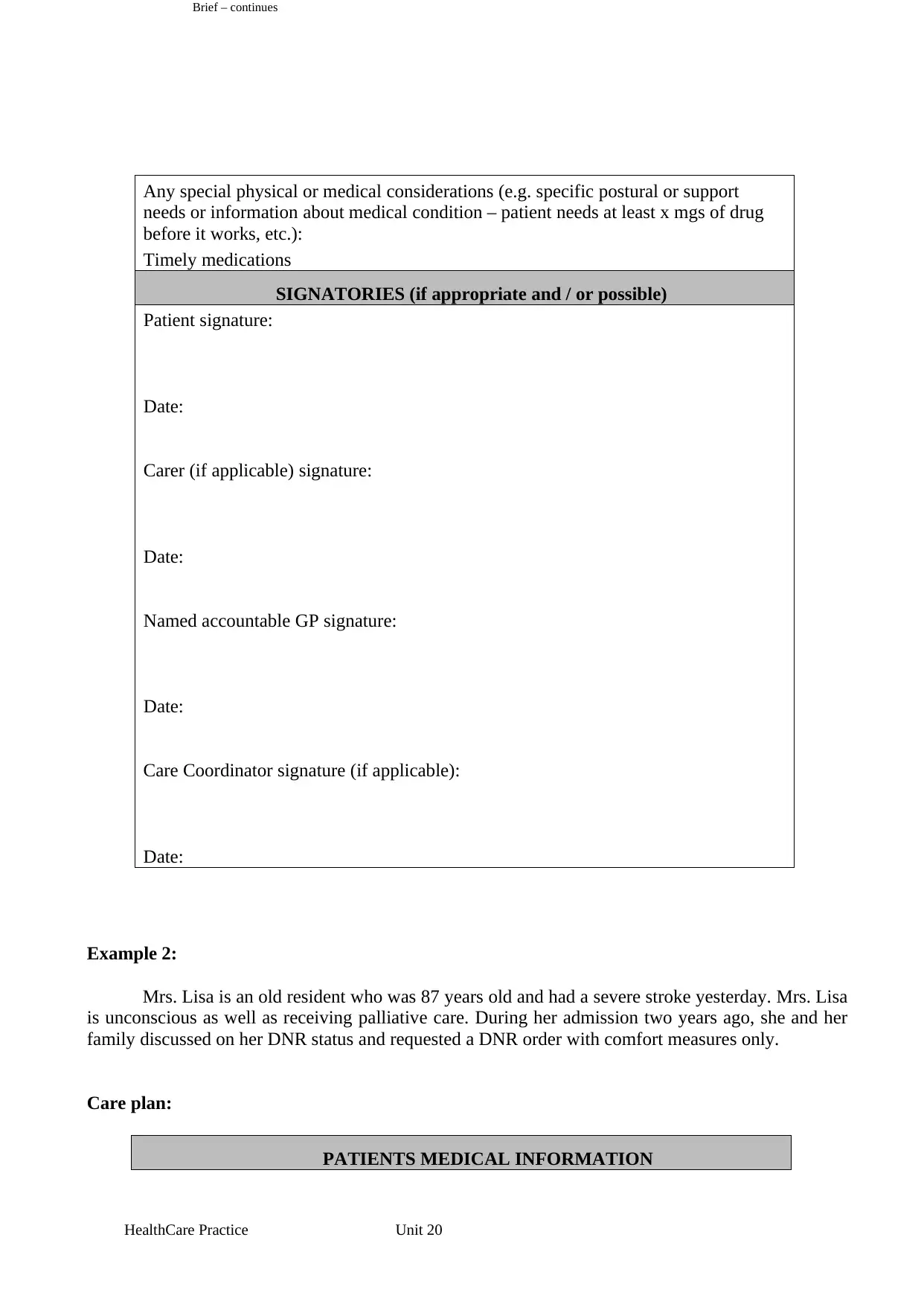
Brief – continues
HealthCare Practice Unit 20
Any special physical or medical considerations (e.g. specific postural or support
needs or information about medical condition – patient needs at least x mgs of drug
before it works, etc.):
Timely medications
SIGNATORIES (if appropriate and / or possible)
Patient signature:
Date:
Carer (if applicable) signature:
Date:
Named accountable GP signature:
Date:
Care Coordinator signature (if applicable):
Date:
Example 2:
Mrs. Lisa is an old resident who was 87 years old and had a severe stroke yesterday. Mrs. Lisa
is unconscious as well as receiving palliative care. During her admission two years ago, she and her
family discussed on her DNR status and requested a DNR order with comfort measures only.
Care plan:
PATIENTS MEDICAL INFORMATION
HealthCare Practice Unit 20
Any special physical or medical considerations (e.g. specific postural or support
needs or information about medical condition – patient needs at least x mgs of drug
before it works, etc.):
Timely medications
SIGNATORIES (if appropriate and / or possible)
Patient signature:
Date:
Carer (if applicable) signature:
Date:
Named accountable GP signature:
Date:
Care Coordinator signature (if applicable):
Date:
Example 2:
Mrs. Lisa is an old resident who was 87 years old and had a severe stroke yesterday. Mrs. Lisa
is unconscious as well as receiving palliative care. During her admission two years ago, she and her
family discussed on her DNR status and requested a DNR order with comfort measures only.
Care plan:
PATIENTS MEDICAL INFORMATION
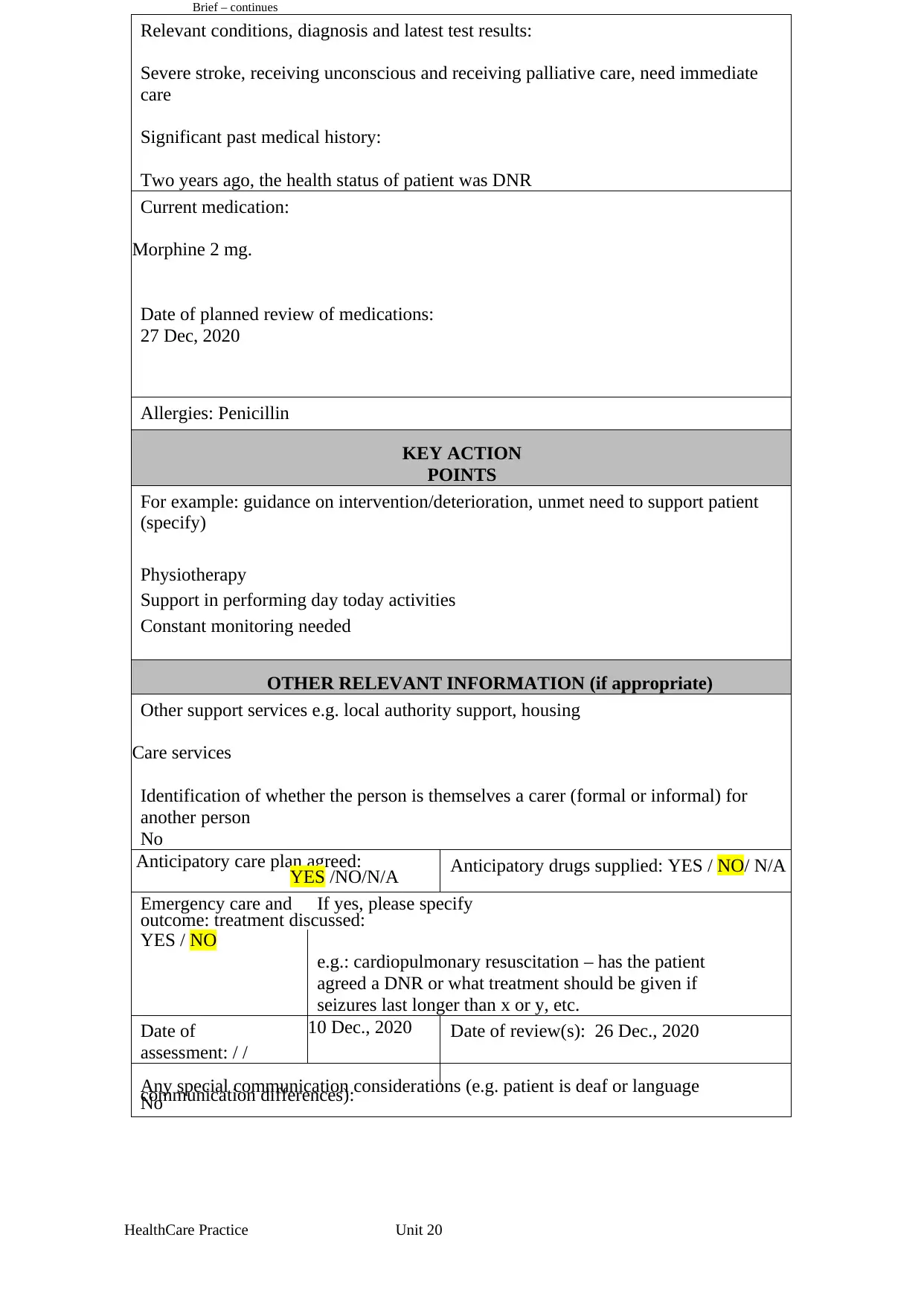
Brief – continues
HealthCare Practice Unit 20
Relevant conditions, diagnosis and latest test results:
Severe stroke, receiving unconscious and receiving palliative care, need immediate
care
Significant past medical history:
Two years ago, the health status of patient was DNR
Current medication:
Morphine 2 mg.
Date of planned review of medications:
27 Dec, 2020
Allergies: Penicillin
KEY ACTION
POINTS
For example: guidance on intervention/deterioration, unmet need to support patient
(specify)
Physiotherapy
Support in performing day today activities
Constant monitoring needed
OTHER RELEVANT INFORMATION (if appropriate)
Other support services e.g. local authority support, housing
Care services
Identification of whether the person is themselves a carer (formal or informal) for
another person
No
Anticipatory care plan agreed:
YES /NO/N/A Anticipatory drugs supplied: YES / NO/ N/A
Emergency care and If yes, please specify
outcome: treatment discussed:
YES / NO
e.g.: cardiopulmonary resuscitation – has the patient
agreed a DNR or what treatment should be given if
seizures last longer than x or y, etc.
Date of
assessment: / /
10 Dec., 2020 Date of review(s): 26 Dec., 2020
Any special communication considerations (e.g. patient is deaf or languagecommunication differences):No
HealthCare Practice Unit 20
Relevant conditions, diagnosis and latest test results:
Severe stroke, receiving unconscious and receiving palliative care, need immediate
care
Significant past medical history:
Two years ago, the health status of patient was DNR
Current medication:
Morphine 2 mg.
Date of planned review of medications:
27 Dec, 2020
Allergies: Penicillin
KEY ACTION
POINTS
For example: guidance on intervention/deterioration, unmet need to support patient
(specify)
Physiotherapy
Support in performing day today activities
Constant monitoring needed
OTHER RELEVANT INFORMATION (if appropriate)
Other support services e.g. local authority support, housing
Care services
Identification of whether the person is themselves a carer (formal or informal) for
another person
No
Anticipatory care plan agreed:
YES /NO/N/A Anticipatory drugs supplied: YES / NO/ N/A
Emergency care and If yes, please specify
outcome: treatment discussed:
YES / NO
e.g.: cardiopulmonary resuscitation – has the patient
agreed a DNR or what treatment should be given if
seizures last longer than x or y, etc.
Date of
assessment: / /
10 Dec., 2020 Date of review(s): 26 Dec., 2020
Any special communication considerations (e.g. patient is deaf or languagecommunication differences):No
⊘ This is a preview!⊘
Do you want full access?
Subscribe today to unlock all pages.

Trusted by 1+ million students worldwide
1 out of 26
Related Documents
Your All-in-One AI-Powered Toolkit for Academic Success.
+13062052269
info@desklib.com
Available 24*7 on WhatsApp / Email
![[object Object]](/_next/static/media/star-bottom.7253800d.svg)
Unlock your academic potential
Copyright © 2020–2025 A2Z Services. All Rights Reserved. Developed and managed by ZUCOL.




